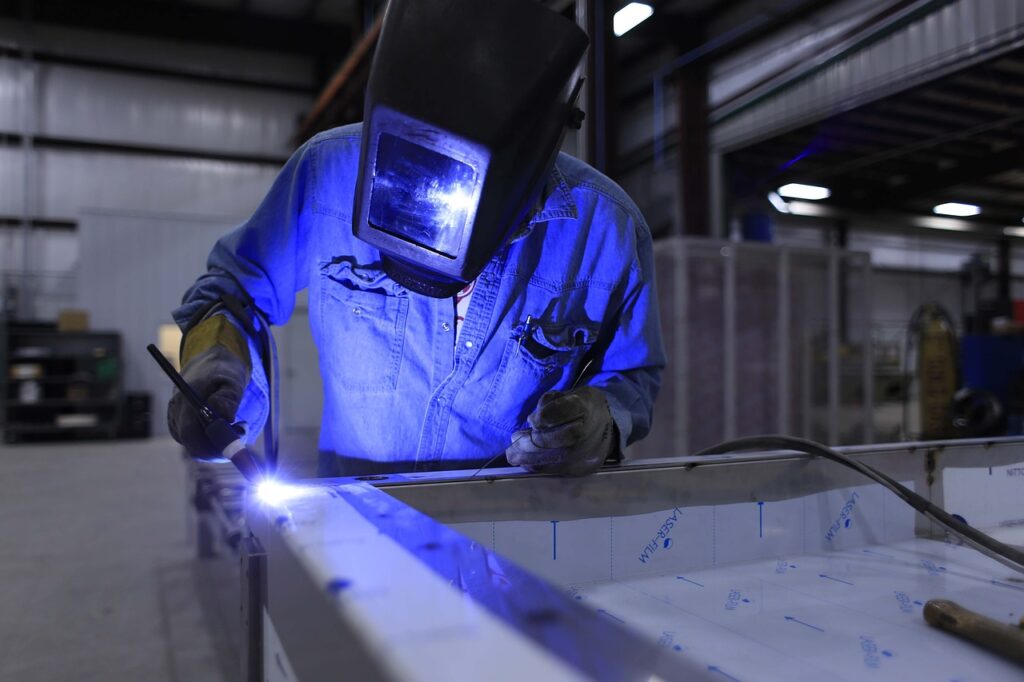Technology has completely transformed the manufacturing process in the last decades. In the past, manufacturers had to handle most of the manufacturing tasks just with pen and paper or an Excel spreadsheet. Now though, even small, local manufacturers can take advantage of cutting-edge technology to streamline their processes and increase their overall efficiency.
There is more to technology in manufacturing than just optimizing production processes though. The technological revolution has impacted every aspect of manufacturing – from inventory management and industrial machines monitoring to demand forecasting.
So in this blog article, we’ll explore how exactly advanced technologies are transforming the manufacturing industry – and how manufacturers can use it to their full potential.
Resources planning and inventory management in the digital age
Production planning can be one of the trickiest manufacturing tasks to do when you have to rely on spreadsheets and guesstimates.
How many times has it happened that you have overestimated how many materials you need for the latest order and had to store the extra materials in your warehouse? Or on the contrary, how many times you ran out of supplies in the middle of production and all manufacturing processes had to be halted?
Too many, too often?
If you or your workers have to keep track of the inventory manually and then update the Excel spreadsheets several times a day, mistakes are bound to happen though. Managing multiple warehouses manually is even trickier – misplacing or losing raw materials is, unfortunately, a daily situation for some manufacturers.
Newest technologies such as ERP and MRP systems, Artificial Intelligence, and Internet of Things devices can make production planning and inventory management far simpler though.
How? Let’s have a look at how exactly manufacturers (both from small factories and large plants) can benefit from implementing those technologies.
Enterprise Resource Planning (ERP) systems
Enterprise resource planning, also called ERP, is a software platform used by businesses to manage various day-to-day business activities such as:
- Manufacturing processes
- Accounting and asset management
- Inventory and warehouse control
- Human resources
- Supply chain management
- Customer relationship
- Forecasting and business intelligence, etc.
It’s basically an “all-in-one” platform through which company owners can control virtually all aspects of their business from a single application. And while ERP platforms can be used in practically any industry, they are the most popular in the manufacturing sector.
For example, the ERP 2022 report from Panorama Consulting indicates that over 26% of manufacturing companies have already implemented an ERP system. What’s driving this interest?
ERP systems can collect, compare and update large amounts of data coming from the factory in real-time and then turn it into visualized insights for business owners. This way, manufacturers don’t have to spend time maintaining dozens of spreadsheets or databases or comparing the data coming from different departments.
Instead, they can hand over most of the data processing, updating, and reporting tasks to the ERP and have the latest data at their fingertips.
However, a regular ERP might sometimes be a bit too large and too expensive for smaller manufacturers. That’s why there are also several MRP (Manufacturing Requirements Planning) platforms that are mainly dedicated to production scheduling, real-time task monitoring, and inventory monitoring.
How Artificial Intelligence (AI) can aid in optimizing material requirements
AI-powered solutions with machine learning are playing an increasingly important role in businesses of all sizes and industries – and the manufacturing sector is no exception here.
This technology’s main strength lies in its ability to process large amounts of data and analyze them for patterns or trends. The algorithms can also “learn” from the data they are processing and use this new knowledge to make better recommendations. By analyzing past demand data for instance, AI can predict when there will be a higher demand for the products and suggest ordering more raw materials to handle the demand.
These abilities make Artificial Intelligence increasingly popular with manufacturers. Statista research, for example, estimates that 60% of manufacturing companies now rely on AI-powered technology, mainly for quality control and inventory management.
As AI algorithms can monitor the warehouses 24/7 and track every material or component added or taken from the inventory, manufacturers no longer need to check the supplies stock themselves.
By analyzing the historical data for patterns, AI can also predict which materials will be required for production, in what amount, and by when those supplies should be available. Manufacturers can then use the information to estimate how much material they will need for their scheduled tasks and order accordingly so that they don’t run out of materials in the middle of the production cycle (or overstock).
Manufacturing plants managers can then use those insights to estimate how much material they’ll need for production and order accordingly so they don’t run out of resources in the middle of production.
That allows them to manage their resources more efficiently but also reduce the costs of purchasing and storing supplies. Since they don’t have to spend time managing the resources or creating reports themselves either, they can focus fully on running and optimizing their business as well.
Real-time inventory management using industrial Internet of Things devices
Statista estimates that in 2022, there were 12 billion active IoT devices – and by 2030, their number will double. It shouldn’t be surprising, considering how valuable those devices can be for both regular users and businesses.
The market size of IoT in manufacturing alone was valued at $50.0 billion in 2021 and is expected to grow to $87.9 billion by 2026!
The reason for this tremendous growth is simple – Internet of Things technology can provide manufacturers with a much greater level of visibility and control over their business than ever before.
To name just a few things for which factory owners can use IoT devices:
- Monitoring the state of each manufacturing machinery or other equipment used through embedded sensors and running predictive maintenance to prevent machine failures and downtime
- Controlling the industrial equipment, warehouses, and shop floor remotely
- Managing their entire supply chain and tracking the raw materials or ready products during transport
- Improving the workers’ safety by analyzing the conditions on the shop floor (such as the level of harmful emissions)
IoT sensors have proven themselves to be especially useful in inventory management. Those devices can be used to track everything – from inventory levels and resource location to the conditions the items are stored in. If you are using raw materials that need to be held in specific conditions, this can be extremely helpful.
For example, let’s say that one of the main materials your manufacturing business is using is leather. Leather is susceptible both to too low humidity (as the material dries then) and too high (as then it might start to grow mold). It shouldn’t be exposed to direct sunlight either, as it might damage the material.
By installing IoT sensors where the material is stored, you can monitor in real-time the temperature and humidity at which the leather is stored and also get notifications whenever the conditions fall outside the optimal ones. By doing so, you can reduce the risk of your materials getting damaged in storage and reduce the number of wasted resources.
That can help you significantly reduce your expenses – not only because you won’t have to order new materials as often, but also because the production costs will be lower.
The impact of technology on production planning and progress tracking
Inventory management isn’t the only thing with which modern manufacturing technology can help though. It can be just as much an asset when it comes to production planning and then progress tracking.
Using the historical and current demand data, ERP (or MRP) systems can precisely estimate how many items should be produced and how many raw materials (and what type) will be needed.
By looking at their updated real-time data inventory meanwhile, manufacturers know exactly whether they have enough materials for smooth production or should they order more. Scheduling dates by which specific tasks or product parts should be ready is also much easier, again thanks to plenty of data about how much time it typically takes to complete the task.
What about the production process itself? Here, the help of platforms such as Manufacturing execution systems (MES) can be invaluable, as those enable manufacturers to track the work-in-progress in real-time and immediately learn about any delays or issues.
How is it better than traditional production scheduling and monitoring though?
The 4 biggest advantages of real-time production tracking
#1 Saves time
How long does it take you and your workers to update the spreadsheets with the production schedules or share the information about who is working on what task right now? Probably too much.
With manufacturing software though, there’s no need to visit the shop floor to see what your manufacturers are doing or call each of them to ask about progress. One look at the dashboard, and you will know who and on what task is working now and if there are any problems you should immediately take care of.
#2 Saves nerves
If you ever had to manage the chaos that happened at the facility whenever:
- someone accidentally overbooked a machine
- there was a miscommunication in the team about the task order
- there was a sudden machine malfunction, etc.
then you know just how stressful trying to get the situation under control can be. Having a full overview of what machines are currently in use, who is working on what task, and is everyone meeting deadlines can prevent most of those frustrating incidents from ever happening again.
#3 Boosts productivity
Keeping everyone on the same page with dozens of different spreadsheets or task details on sticky notes? That’s quite a tricky task – not to say, nearly impossible.
What if your workers had a detailed schedule, together with detailed information on what tasks they have to complete and what steps to take, available to them whenever they want? And also with information on who is working on which machine and for long the machine will be occupied?
Keeping everyone in the loop and speeding up the production is then a breeze.
#4 Reduces operational costs
Last but not least – automatic production tracking can also save you a good part of your budget by streamlining the entire manufacturing process.
- There’s no need to travel between multiple shop floors to monitor the progress, saving you plenty of time
- The communication between the workers is much smoother, boosting productivity
- Thanks to step-by-step instructions and task comments visible to anyone, there’s a much lower risk of errors and delays
- In case there are any issues you need to take care of (such as machine malfunction), you can quickly add changes to the schedule and notify everyone about those.
In this way, you can optimize all tasks in the production cycle, ensure that deadlines are met, and minimize errors and material waste. For you as the manufacturer, that means better quality products, finished faster and at a much lower cost.
And as the production schedule can be monitored remotely, you can keep an eye on the progress and deadlines even if you are away from the factory.
Do you want to see all those benefits of real-time progress in your own factory as well? Then how about letting our Prodio lend you a hand?

Sign up for a free 14-trial or schedule a demo call with our team – and soon, you’ll be able to say goodbye to Excel spreadsheets and sticky notes.
What other technical innovations are now used in the manufacturing industry?
Smart IoT devices, AI-powered systems, and various sophisticated systems for handling manufacturing tasks are just the start of what technological advancement has to offer for manufacturing plant owners. So let’s have a quick look at what other innovations are now often used in the manufacturing industry:
Advanced Robotics
Over 3.5 million industrial robots were operating in factories worldwide in 2022, mostly handling repetitive, time-consuming, or hazardous work. Walmart, for example, uses AI-powered Floor scrubber robots to both clean their warehouses but also monitor the inventory.
Digital twins
A digital twin is a virtual replica of a process, product, or even entire production line. Through those, manufacturers can visualize how the ready product will look like or simulate a given production process to search for potential issues. As the digital copy is also automatically updated as production goes on, it can almost perfectly reproduce the real-world product’s design and behavior.
Additive manufacturing
Additive manufacturing or 3D printing allows manufacturers to design and then print various objects by using digital models of those objects. Those are especially convenient for creating prototypes of products, as printing an entire object from a model takes less time than crafting it manually and the digital copy can be easily modified.
Cloud computing
With cloud computing, manufacturers no longer need to manage their on-premise servers for storing and processing data but can use various cloud storage services for the task. Most modern manufacturing platforms are also cloud-based, making them more affordable, faster to implement and also letting manufacturers use those from any device or location they need.
Machine vision
When machine vision technology is combined with a human eye, the number of defective products that leave the production line can be significantly reduced.
Those systems can monitor each product on the conveyor belt and then quickly and accurately detect any flaws or issues within the product. This can lower production costs and reduce product waste while making the inspection process less tedious for employees.
Discover technology in manufacturing industry!
All those technological advancements may have made you wonder if human workers will even be needed in the future. Rest assured – we are still very far away from being able to replace human manufacturers with AI and sophisticated software.
What technology can do for us though is make the manufacturing sector more efficient but also safer for the workers. Less tedious, manual work, better communication among all workers, and higher product quality at lower costs – what’s here not to like?
Do you want to see how modern technology can transform business as well? Then, how about starting by having a chat with our sales team about how Prodio can both smoothen your production line but also make your workers happier?
Reach out to us to find out how we can take your business into the future!
Modern technology in manufacturing FAQ
What are the main problems with manual production planning?
It is still quite common for manufacturers to plan their production using spreadsheets or sticky notes only. However, relying on the data from those documents can be quite risky, since the information inside them might be inaccurate or outdated. That might lead the managers to, for example, assume they have more raw resources in the inventory than they actually have and run out of that midway through the tasks.
Sharing information about the production phases through several files or emails can also lead to misunderstandings and , in consequence, delays.
What are some examples of modern software systems used in manufacturing?
Manufacturing facilities commonly use Manufacturing Resource Planning (MRP) or Enterprise Resource Planning (ERP) platforms to manage their resources and business processes more efficiently. Tools such as manufacturing execution system (MES) meanwhile allow manufacturers to plan their production more precisely and also monitor the progress in real-time.
How has technology transformed material resource planning in manufacturing?
Artificial intelligence, IoT devices and dedicated software can enable manufacturers to track their inventory stock and the number of resources used in real-time, making it easier for them to use their resources efficiently.
IoT sensors can also monitor storage conditions, preventing material damage and reducing waste.
What are the advantages of automated production task tracking in manufacturing facilities?
Using task tracking solutions allow manufacturers to monitor production progress and deadlines remotely and also ensure that everyone follows the instructions correctly.
Workers meanwhile can quickly see at what stage other workers are now and which machines are in use straight on the tracking app’s dashboard. That way, they don’t have to ask other workers or their managers about the progress and whether they can start their work.
Which other modern manufacturing technologies are frequently used today?
Digital twins and 3D printing are now often used by manufacturers to create product prototypes and visualizations before developing ready products. Computer vision meanwhile is incredibly useful in quality control, as it can spot product faults or issues faster and more accurately.

 Marek Mrowiec
Marek Mrowiec 

